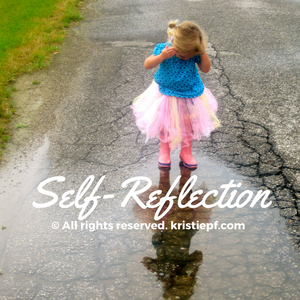 Carl Jung stated, “If there is anything we wish to change in the child, see if there isn’t something we can change in ourselves first.”
Carl Jung stated, “If there is anything we wish to change in the child, see if there isn’t something we can change in ourselves first.”
Beginning a journey toward change, however, can feel like an overwhelming task. You might wonder, “Where do I start?”, “What steps might I need to take to affect change?” or “How do I know if I am having an impact?”
- A goal, and
- An awareness of where you are in relation to that goal
Well, unfortunately, the minute the word “aware” is used…we know the journey to change isn’t quite as simple as just two things. In fact, increasing awareness, particularly self-awareness, relies upon a whole host of interrelated skills from self-regulation to discernment, to even self-compassion.
Greater awareness also depends upon our ability to reflect. This process of reflection is an ability to think about something – to think about something for a reason so a comparison can be made….not a judgement or a criticism…or even something that is more narcissistic…but rather, a comparison that allows one’s current state, progress, and next steps to be identified.
And in particular, self-reflection become a critical element of the change process. Self-reflection is a call to action…not just an opportunity to admire the problem. Self-reflection leads to actionable steps, which allow you to achieve a goal or desired outcome. Without self-reflection you are staring a map without being able to see the “you are here” indicator, and not knowing where it is you are trying to go.
Here are a few tips for improving your self-reflection skills:
- Make time for daily self-reflection…our ability to change because of the amazing plasticity of the brain can only occur with practice
- Aim to write or otherwise document your reflections….thinking is good, but the act of documenting is even better
- Be curious not critical…explore your thoughts, feelings, and even actions from a place of wonder
- Ask yourself questions that lead to more than descriptions or an analysis of current facts…the ultimate goal of self-reflection is to gain new insight and identify steps for the future
When it comes down to it, in order to help children learn, we start by studying (aka reflecting) the way we introduce, implement, and individualize teaching strategies to positively impact their social, emotional, and cognitive growth.
To help you begin a journey toward greater reflection, consider thinking of it as as a process having four parts, or steps: inquiry, observation, planning, and implementation.
Each step builds upon the last, and together they provide a framework to help you stay focused on on your goals for affecting change. This framework for self-reflection may be followed during individual self-reflection opportunities and/or when reflecting with peers, supervisors, or coaches.
STEP ONE:
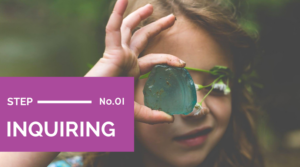
- Choose a topic or an area of focus. For example, do you want to examine a particular activity such as circle time, a set of teaching strategies such as those designed to foster conflict resolution skills, or perhaps ways to smooth out transitions?
- Write down a question that will guide your reflection related to your area of focus. For example, “What might I do to strengthen my role in teaching children to resolve conflicts?” or “What skills do I need to teach children to resolve conflicts on their own, and what framework for conflict resolution might I use?”
- Take a moment to pause and consider, “What are my values/perceptions/beliefs in regard to this topic?” You might even ask yourself, “Are my values aligned with ‘best practice,’ current practice, and required policies?” If there isn’t alignment, consider how this is impacting your health, well-being, and decision-making. Look for where you might find a connection between what you believe and what might be considered developmentally appropriate practice.
- Before moving to the next step, aim to add one more self-reflection question. Try something similar to this, “How might I individualize my teaching practice(s) on this topic to meet the needs of all children in my class?” Asking this final question allows you to consider differences among children and ensure all are fully included in your planning.
STEP TWO:
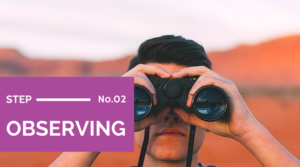
- One of the best ways to engage in observation is to see yourself in action. Be brave and videotape a part of your practice. Think of it this way…when you are in the movie, you can’t see the movie. This means that self-reflection will always be limited because you can’t truly “see” yourself unless you videotape yourself in action. Even if you have someone come in to observe, that person cannot accurately capture everything a video can.
- The duration of the observation will depend upon the specific teaching practice chosen for reflection, but as a guide, consider chunks of time from 3-5 minutes. If videotape is used, collect several segments or clips, then choose the clips that are most closely related to the selected topic. For instance, if your goal is to strengthen reciprocal feedback loops with children as they engage in play, have the person videotaping you do so for the entire free choice time, collecting clips that are 3-5 minutes in length, which serve as examples of your efforts to engage in those feedback loops. These clips should examples of both strengths and missed opportunities to engage in the practices if possible. If you did not videotape, then the “observation” is finding a time when you are not with the children to think back and take notes on your teaching practices or the observation is the notes someone else took about your practice during this time frame.
- The observation should include examples, either video clips or written notes, of specific teaching practices observed: the teacher’s strengths and how those strengths were directly tied to child outcomes. For example, ask yourself, “What did I/my co-teachers do?”, “What was the impact on the child?”, or “What skill might that child be developing as a result?”. If peers, supervisors, or coaches are observing, they will be asking themselves these questions about teacher strengths and taking notes of the answers as they conduct their classroom observation.
- While observing for strengths, make note of possibilities for new practices as well. Questions to consider may include, “What might I do next time in this situation?”, “How might I carry out that practice I learned about last week?”, “What skills might be learned by the children if I were to __________?”.
- It’s easy to get caught up in watching the children, or thinking only about the children’s behavior, so do your best to connect what is observed related to teacher practice.
STEP THREE:

- The planning step begins by reflecting upon the strengths identified during the observation. Aim to discuss 3-5 strengths observed by each person included in the planning process (coach, peer, teacher). It’s important for the teacher to identify his or her strengths as well. Here’s an example:
During clean up time, teacher Zania was butterflying from area to area encouraging children by giving positive, descriptive acknowledgments to the children such as, “Dylan and Grace, you are picking up all the blocks!” or “Alexis, you are almost done putting away the paint supplies, you are being so helpful!” (teaching practice). As a result, the children cleaned up and transitioned to circle time in less than five minutes (observed desired behavior). With this, the children are developing the skills of following through with tasks, being responsible for their work, and working together as a group (potential skills developed).
- Building upon the strengths identified, plan for ways to implement next steps or additional teaching practices that may help answer the question or questions identified in the first step, inquiry. Remember, reflection is about changing your teaching practice to help support change in the children, so keep your focus on what you and other adults might do in addition to the strong teaching practices already observed.
- Come up with a specific plan to carry out these next steps so that it’s clear what teaching practices will be used and what skills you are targeting to develop in the children. Here’s an example:
We would like to start offering children jobs as “community monitors” during clean-up, encouraging the monitors to acknowledge peers they see cleaning up/working together (specific plan to carry practice out). The goal is to teach children how to observe for respectful, safe and friendly behavior in order to build connection among peers/community as well as strengthen the internal narrative of children engaging in appropriate behaviors (potential skills developed). Teachers will model this behavior for the community monitors and even whisper ideas to them if they miss a chance to acknowledge a child’s efforts to clean up. We also want to follow up with community monitors at appropriate times to inquire about their experience giving acknowledgement with open-ended questions. We will ask questions such as “How did it feel doing your job today? What did you like about it? How do you think the other kids felt when you acknowledged them, etc.?” (teaching practices).
- As you are planning for next steps, make sure you are pausing to ask yourself why or how that particular teaching practice will support the skills you hope to develop in the children. Understanding the “why,” or the conceptual underpinnings, of your next steps will help you move from first-order change (temporary) to second-order change (lasting change). For example, putting up a visual schedule is first-order change; but, understanding why a visual schedule may help children transition throughout the day, why it may help decrease anxiety in children, or why it may increase the child’s ability to complete an undesired task, are examples of teaching for second-order change. When you can articulate the specific ways that a practice leads to a desired outcome, you are more likely to implement that practice appropriately and sustain the use of the practice. To help with this step, try asking and answering questions such as, “How does ________ promote social and emotional development and prevent challenging behavior?” or “How does ______ support developmentally appropriate learning of this concept?”
STEP FOUR: 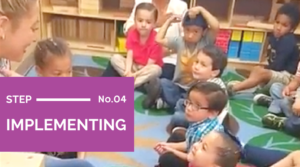
- Now it’s time to try out your plan! It’s important during this step that you set the intention to engage in continual self-reflection in order to implement the strategies you’ve agreed to try out with fidelity (as they were intended to be used). Notice what you are doing that is working, and what might not seem to be going so well. Teachers often get discouraged when a plan doesn’t “work,” but it may be that they strategies chosen are not being implemented correctly. It can be challenging to put a new practice into action.
- To help with this, continue the self-reflection process during implementation. Continue to inquire about your teaching efforts, observe what’s happening in the classroom, revisit the plan and revise the plan.
- To stay motivated, it helps to share what you are doing with a like-minded friend, colleague, or mentor. Try finding someone you work with or trust in your personal life to share your experience of making changes in your teaching practices. Research also shows that keeping your focus small, as suggested above, and tuning in to notice even slight positive changes that occur as a result, can help you stay with something new. Try scanning the room throughout the day for what is going well, not just what is out of order, to notice how your effort to engage in this self-reflection framework to change your teaching practice is positively impacting the children.
- Finally, remember to engage in this framework with self-compassion and mindfulness, attending to your strengths, acknowledging your best intentions, and offering loving-kindness to yourself at every step! We do “better” when we feel better!
For more information about this framework for self-reflection, please email Laura Fish at laura@laurafishtherapy.com or visit laurafishtherapy.com/consulting.html for training and coaching information.
Blog Co-Author: Laura Fish MS, LMFT
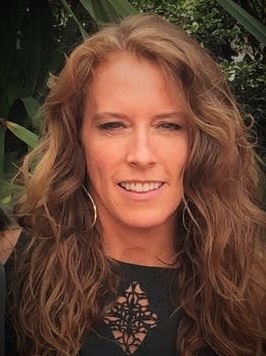 Laura’s interest in working with children and families began at the University of California at Berkeley, where she graduated with a B.S. in Psychology. While earning her Masters in Counseling from San Diego State University, she worked as a preschool teacher, developing an intimate understanding of the challenges that teachers face.
Laura’s interest in working with children and families began at the University of California at Berkeley, where she graduated with a B.S. in Psychology. While earning her Masters in Counseling from San Diego State University, she worked as a preschool teacher, developing an intimate understanding of the challenges that teachers face.
After earning her master’s degree, Laura maintained her connection with the early childhood education field serving as a mental health consultant for public, private pay, and Head Start infant, toddler and preschool early education programs, including Montessori and Reggio Emilia inspired programs. This work included partnering with child welfare and special education departments to provide support for children with identified risk factors, special needs or disabilities to be fully included.
Since that early start, Laura has worked as a therapist with child, adolescent and adult populations in various settings, including community-based wraparound service programs for CPS involved families and mental health consultation for early childhood programs. For the past 10 years she has provided training and coaching on social and emotional development for early childhood education, elementary and high school teachers, mental health consultants and coaches.
As an advocate for teachers, Laura works hard to provide them with meaningful information and strategies that are intended to make their jobs less stressful and ensure that children of all ages are safe physically, mentally, and emotionally. She grounds her work with educators and parents in teachings about the brain so they may provide children with the responsive caregiving they deserve based on science, not habits.